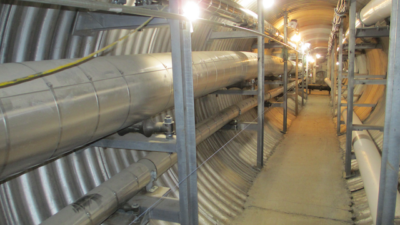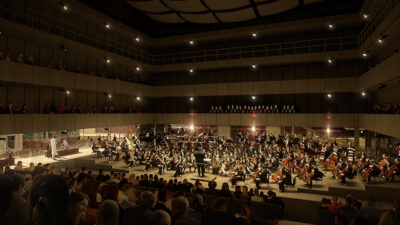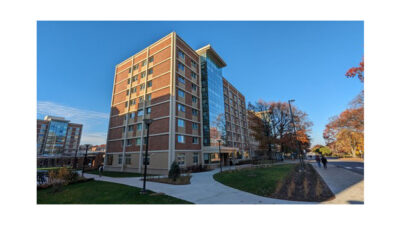Thanks to the growing application of energy management and control systems (EMCS), it has become possible to monitor equipment much more closely than what was possible with pneumatic and electric control systems.
For the original paper and others, visit www.peci.org/ncbc . Consulting-Specifying Engineer is the media sponsor for NCBC.
Thanks to the growing application of energy management and control systems (EMCS), it has become possible to monitor equipment much more closely than what was possible with pneumatic and electric control systems. When an EMCS includes controls “at the zone level,” it typically means that controls extend beyond the central mechanical rooms to individual air terminals serving spaces in all parts of the building. For new installations, this is usually the case.
For retrofits or upgrades of existing facilities, however, extending an EMCS to the zone level is often too costly, and only individual pieces of equipment or mechanical rooms are equipped with modern controls. This type of retrofit for older systems does not allow use of demand-based reset as described below.
A traditional approach to controlling systems is to specify fixed setpoints. A typical example would be to run a rooftop package unit with a fixed supply air temperature setpoint of 55 F and a fixed supply pressure setpoint of 1.5 in. water gauge. This assures stable operation and reduces comfort problems and callbacks. It also assures less than optimal energy efficiency.
Since 1999, ASHRAE Standard 90.1 requires the use of a demand-based static pressure setpoint reset for air systems with zone level controls, as does California’s energy code, part 6 of Title 24. Table 1 shows a quick overview of the regulatory landscape.
As shown in Table 1 , air systems typically are required to have pressure setpoint reset while not having temperature setpoint reset. Hydronic systems (see Table 2 ) are the reverse; regulations require the use of temperature setpoint reset while not requiring the use of pressure setpoint reset.
For an explanation of this, we’ll begin by looking at indicators used for building demand, and the resulting reset mechanisms that make sense.
Building demand
To begin, let’s describe how to quantify building demand, because that’s what we have to respond to. The following list describes typical demand indicators:
Poor demand indicators for supply air pressure reset
Air terminal damper end-switch (in the absence of a flow sensor, on legacy systems): This only indicates that a damper is wide open. The damper may at that point be receiving in excess of the design airflow rate, so this is not a good indicator of required pressure.
Approximate damper position: On floating actuators, which receive only “open” or “close” commands, there is no direct indication of damper position. By summarizing the “open” and “close” commands over time, the damper position can be approximated, but usually is not very accurate when the damper is not driven to an auto-zero position at regular intervals (example: once every 24 hours).
Good demand indicators for supply air pressure reset
Comparison of airflow to setpoint: In lieu of approximating damper position, a call for pressure can be generated when the airflow of a zone is below setpoint for a certain period of time. This method can be used when damper position is unavailable. Note that this indicator can only be used for the trim-and-respond logic described below, not for the proportional-integral-derivative (PID)—based reset logic.
Accurate damper position: When pressure-independent terminals (with flow sensor) are used, a fully open damper is an indication of insufficient flow. Note that this is not the case in terminals without flow sensors (see above). The damper position can be sensed with a modulating actuator, or by using a floating point actuator with position feedback. The floating point actuator position, approximated by summarizing “open” and “close” commands over time, is accompanied by driving the damper to zero position for several seconds at regular intervals to eliminate inaccuracy in the approximated position.
Poor demand indicators for supply air temperature reset
Return air temperature: Provides an average of what is occurring throughout the entire building, or at least a wing, floor, or large section of the building. As such, we easily will overlook a number of rooms that are not receiving sufficient cooling or heating, because their operations are lost in the averaging effect.
Typical zone sensors: This is a technique often used for retrofits of older pneumatic systems when installing zone-level EMCS is too expensive. One sensor may be installed at the top floor in a north-facing zone with the intent to reflect the coldest area in the building, while another sensor may be installed in the southwest corner of the building, with the intent to reflect the warmest area in the building. The system then judges whether the building is “too cold” or “too hot” based on the readings of these typical sensors. The sensors may become bad indicators due to churn in the area in question, or due to local load changes like small space heaters that provide local comfort.
Outside air temperature: For buildings with large internal or solar load components, this may lead to incorrect adjustments. For example, take a building with high internal loads that are constant throughout the day. Resetting supply air temperature (for energy savings through less cooling) at a cooler time of day may not work. Thanks to the high internal loads, we may end up overheating the spaces served. Because we’re only looking at outside air, and not the spaces themselves, this is a poor overall indicator of building demand.
Good demand indicators for supply air temperature reset
When an air terminal in cooling meets the required airflow but fails to achieve comfort conditions in the space served, it requires colder supply air. The same is true in reverse for heating. Thus, the output of the cooling or heating PID loop of an air terminal serves as a good demand indicator for supply air temperature.
Poor demand indicators for chilled/hot water pressure reset
Valve position is generally a poor indicator of pressure demand, because no flow measurement is available at most control valves for coils. Thus, a wide-open valve may receive in excess of design flow and would not be a good indicator for additional pressure.
Good demand indicators for chilled/hot water pressure reset
In a hydronic campus heating system, each building may have a heat exchanger with a Btu meter indicating flow. If this is used, the measured flow can be compared to design flow and used to indicate demand for more pressure.
Poor demand indicators for chilled/hot water temperature reset
Return water temperature provides an average of multiple coils and will not reflect insufficient heating or cooling of particular coils.
Typical zone sensors and outside air temperature (see supply air temperature reset)
Output from the heating or cooling PID loop: Unlike the good indicator for air temperature reset, in hydronic systems we typically lack flow sensors. Thus, a heating or cooling loop that is not satisfied may be caused by insufficient flow. As such, neither the PID loop output nor the valve position is a very good indicators for reset strategies.
It now becomes clear why regulations focus on pressure-based reset in airsystems while not requiring pressure resets in hydronic systems; there typically are good indicators for pressure demand in air systems, but not in hydronic systems.
Similarly, for temperature resets, there are no good indicators in hydronic systems. There are some poor indicators, and they may be used, but do not have to be used if variable flow systems are employed. The intent behind this language is that the majority of energy savings will come from use of variable flow, which may be attained by either fixed pressure setpoint or variable pressure setpoint.
For air systems, terminal control loop output is a good indicator of demand; however, this is not mandated in any of the regulations listed in Table 1 . This is because a temperature reset range has to be chosen well to ensure energy savings. Providing very warm supply temperatures has the potential to undo cooling energy savings through increased fan energy. However, this is not inherent in the principle of the reset, and depends on the selected setpoints rather than the method itself.
Sequences of operation
Using the indicators of building demand defined above, we can now create sequences of operation that react in accordance with changing building demand. There are two such sets of sequences: One addresses pressure reset, and one addresses temperature reset.
Each set of sequences is written in two ways, using either a PID-based reset method or a trim-and-respond based reset method. We will look at both methods in detail.
PID-based reset control sequences
Supply air pressure reset: The static pressure setpoint shall be reset by mapping the output of a direct acting PID loop to a setpoint range of 0.15 in. (0% PID output) to 1.5 in. (100% PID output). The input of the PID loop is the most open damper with a setpoint of 90% (adjustable). When the fan is proven off, disable the PID loop to prevent wind-up and freeze the output at zero. The loop shall be tuned to react slowly.
Supply air temperature reset: During occupied mode, the supply air temperature setpoint is reset from T-min (53 F) when the outdoor air temperature is 70 F and above, proportionally up to T-max when the outdoor air temperature is 60 F and below. T-max shall be reset by mapping the output of a direct acting PID loop to a setpoint range between 65 F (0% PID output) and 55 F (100% PID output). The input to the reset loop is the highest zone cooling loop output with a setpoint of 99% or greater (adjustable). When the fan is proven off, disable the PID loop to prevent wind-up and freeze the output at zero. The loop shall be tuned to react slowly.
Trim-and-respond based reset control sequences
Supply air pressure reset: Static pressure setpoint shall be reset using trim and respond logic within the range of 0.15 to 1.5 in. When the fan is off, freeze setpoint at the minimum value (0.15 in.). While fan is proven on, every 2 min decrease the setpoint by 0.04 in. if there is one (adjustable) or fewer pressure requests. If there is more than one (adjustable) pressure request, increase the setpoint by 0.04 in. Where variable air volume (VAV) zone damper position is known, a pressure request is generated when any VAV damper served by the system is wide open until it drops to 90% open. Where VAV zone damper position is unknown, a pressure request is made when the ratio of the zone’s actual supply airflow to supply airflow setpoint is less than 90% until it rises to 100%.
Supply air temperature reset: During occupied mode, the supply air temperature setpoint is reset from T-min (53 F) when the outdoor air temperature is 70 F and above, proportionally up to T-max when the outdoor air temperature is 60 F and below. T-max shall be reset using trim and respond logic within the range of 55 to 65 F. When the fan is off, freeze T-max at the maximum value (65 F). While the fan is proven on, every 2 min increase the setpoint by 0.2 F if there is one (adjustable) or fewer zone cooling requests. If there is more than one (adjustable) cooling request, decrease the setpoint by 0.3 F. A cooling request is generated when the cooling loop of any zone served by the system is greater than 99% until it falls to 90%.
Practical experiences
The sequences of operations listed in this article will all work. Through practical experience, the trim-and-respond logic offers some advantages.
For one thing, it is much easier to tune; the reset loops have to act very slowly in order to function correctly. Quite often, an installer or controls technician in the field will install PID-based logic using the default “out of the box” PID parameters, which are typically much too fast for a reset loop. As a result, the loop will reset every few minutes, as if it were a reheat valve responding to VAV discharge temperature. This kind of response speed is much too fast and will make the entire building system “oscillate” as all components become unstable.
The reset loop should normally work in cycles of hours, or even in a daily cycle. After all, its ultimate function is to adjust for the building demand as it varies due to weather or internal loads. An occasional peak may be present due to a particular load shift, but the reaction typically will be slow. Tuning a PID loop to respond in a matter of hours rather than minutes requires that the proportional gain (P) and integral gain (I) be set to values that are 10 to 100 times lower than typical PID loop values. Finding the correct balance of PID parameters that provide stable operation and sufficient response speed can take several days to weeks of tuning, and requires a trained operator.
Figures 1 and 2 show an example of a chilled water loop with demand-based pressure reset using valve position, aimed at keeping the most open chilled water valve at 90% setpoint. As mentioned in the section on indicators, using valve position is a poor indicator, but it still works slightly better than a fixed pressure setpoint as long as there are no “rogue” zones (due to fouling or design problems).
This loop required about a month to tune correctly, but ended up cutting pump energy by about 85%, as the main pump ultimately ran at an average of about 25% speed, down from the initial (fixed) speed of 50% that was selected before a demand-based loop was implemented. (Note that in this case, three-way valves were also converted to two-way valves, so that the cubic equation of power versus pump speed held true, as opposed to systems where only pressure is changed but not flow, in which case the correlation is linear.)
During this month of tuning, only intermittent access to the system was required for minutes at a time to examine results from previous days or to look at performance changes over the weekend versus weekdays, and to change PID parameters slightly. For this kind of work, a Web interface is vital, since it can limit the amount of time required for such adjustments to literally 30 min, whereas visiting the job-site might take half a day or more.
In general, a trim-and-respond loop will not require as much tuning as a PID-based reset method. In addition, the reaction speed can be set to fast for ramping up pump or fan speed (example: to react to Monday morning occupancy) while it can be set to slow for ramping down (to help stabilize a loop). In general, a PID loop does not allow tuning of this kind, as the reaction speed is inherently linked to the process signal and the set of fixed PID parameters.
Table 1 : Regulatory requirements for air systems
System type
Air
Reset mechanism
Pressure setpoint reset
Temperature setpoint reset
Standard 90.1-2004
Required, demand-based,
Not required
2006 IECC
Required, demand-based,
Not required
2005 California T24
Required, demand-based,
Required, except for systems with variable speed drives,
Table 2 : Regulatory requirements for hydronic systems
System type
Hydronic
Source for all tables: Taylor Engineering
Reset mechanism
Pressure setpoint reset
Temperature setpoint reset
Standard 90.1-2004
Not required
Required, except for variable flow systems,
2006 IECC
Not required
Required, except for variable flow systems,
2005 California T24
Not required
Required, except for variable flow systems,
Table 3 : Overview of demand indicators
System type
Air
Hydronic
Indicator for:
Pressure reset
Temperature reset
Pressure reset
Temperature reset
Poor indicators
Air terminal damper end-switch
Return air temperature
Valve position
Return water temperature
Typical zone sensors
Typical zone sensors
Approximate damper position
Outside air temperature
Outside air temperature
Valve cooling/heating control loop output
Good indicators
Accurate damper position
Air terminal cooling/heating control loop output
Flow meter reading versus flow setpoint
Airflow reading versus airflow setpoint
Author Information
Seidl is a member of ASHRAE’s guideline committee GPC1.2, at present developing a guideline for commissioning existing buildings, and ASHRAE’s technical committee 7.5 on smart building systems.



